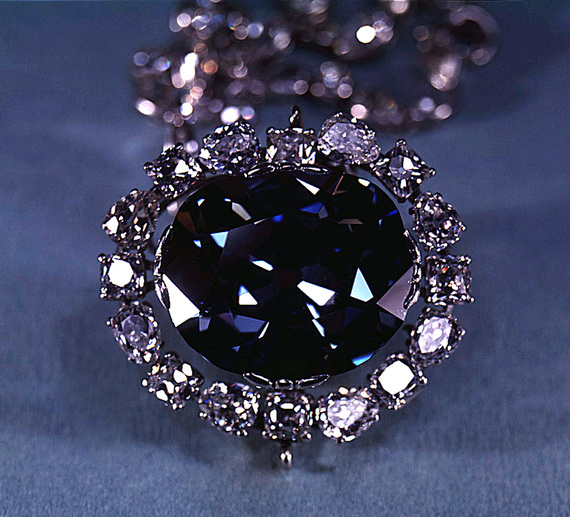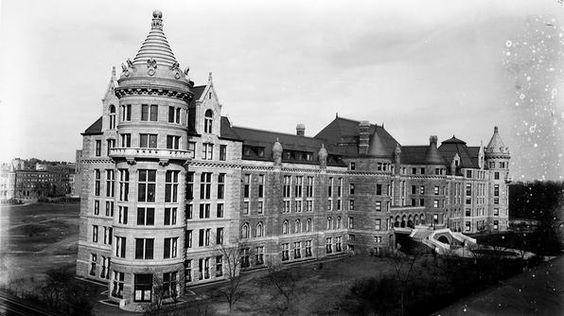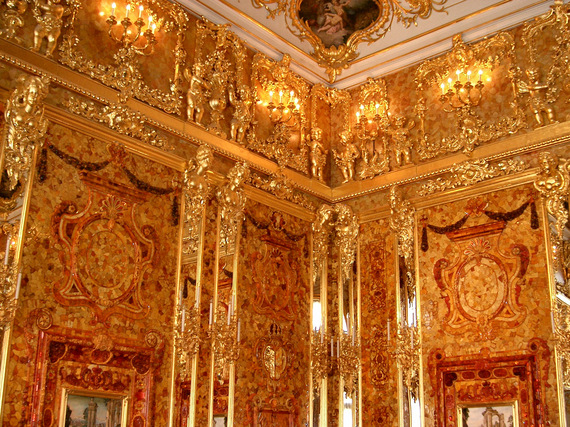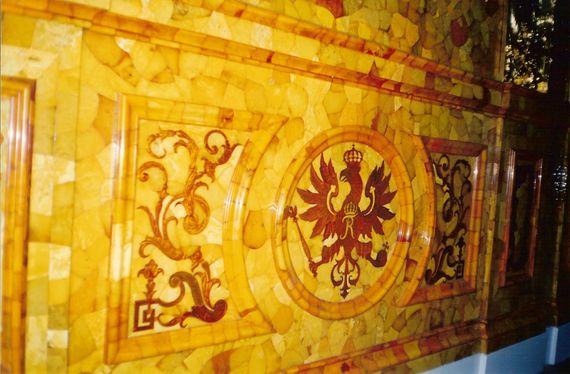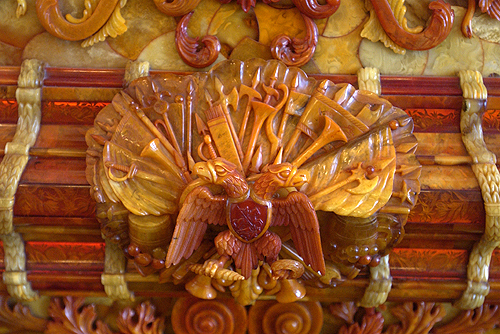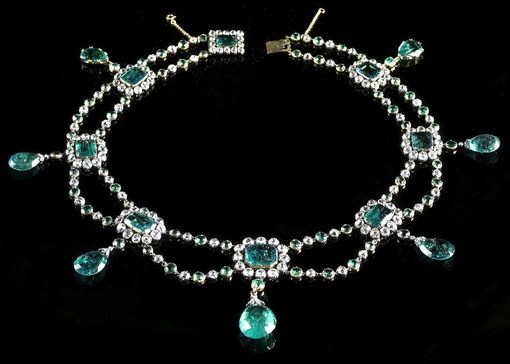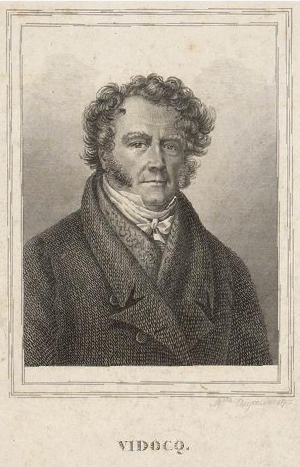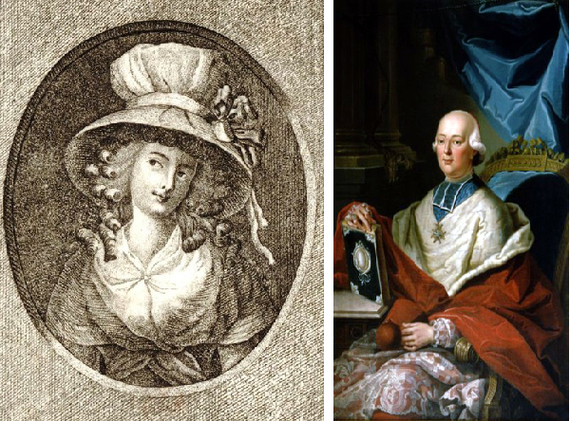We all know that beauty addles the mind -- but an interesting, though lesser known fact is that it's our motor cerebellum that's activated in the presence of something gorgeous. What that means is: you see something desirable, and while the pleasure centers of your brain certainly light up, it's not so much the addictive parts or the warm and fuzzy feeling parts that are first and foremost set humming -- it's the part of your brain that literally controls fine motor skills.
As in reaching out and grabbing.
Maybe that uncontrollable physical impulse, the one that comes before thought and reason, helps explain why throughout history, the prettiest of pretties; jewelry and gems, have been the objects most often coveted and most frequently stolen.
We've all been known to behave badly in the presence of beauty -- but some people take it a little far. From carefully laid plans to simple crimes of opportunity -- and even the occasional impulse grab and dash (blame your motor cortex), the following is a count down of the 9 boldest, strangest, and in some cases, stupidest gem heists on record.
9: Is That a Scepter In Your Pants?
I guess if you're gonna steal jewelry, the crown jewels of England are sort of the brass ring. Not just because they're so great -- although they are pretty great -- but because they're held in the fortress-like Tower of London, and surrounded by more guards than the Pope.
You've gotta have a lot of confidence to think you can steal from the Tower. In 1671 an Irishman named Thomas Blood decided that he was up to the challenge. He engaged in an elaborate plan so ridiculous that it almost qualifies as performance art, with or without a successful jewel heist. His shameless plan involved costumes, fake titles, whole fake daily routine, a fake life and a fake family: his fake wife (really a hired prostitute), helped him convince Talbot Edwards, the 'Keeper of the Jewels,' that their fake nephew would definitely for real marry his homely spinster daughter.
Score -- if you're Edwards.
Because Thomas Blood and his cohorts were (fake) aristocrats, and because they were just, you know, practically family at this point, Talbot Edwards let them in to the inner sanctum, totally unguarded, to see the jewels. It was a super special private viewing -- during which the theives knocked the Keeper out cold. While Edwards drooled on the floor, Blood and his gang didn't just steal the jewels, they smashed them as soundly as they had Talbot Edwards' head.
Using mallets they crushed the crown jewels; flattening the crown itself and sawing a scepter in half, making them supposedly portable enough that they could (I kid you not) shove them down their pants. Their bright idea was to then just casually stroll out with them. Obviously it didn't work. Maybe having a load of destroyed treasure in your shorts makes you walk funny. Or maybe it was all the smashing and banging that tipped off the other guards. Either way, the thieves were almost immediately tackled and apprehended while trying to leave the Tower.
Thomas Blood was arrested, and the now seriously trashed Crown jewels were recovered. But, oddly enough, Blood wasn't executed. In fact, in the end, he didn't even walk away empty handed. King Charles II found the whole caper was so amusing that he gifted Blood his own genuine title and estate in Ireland.
I guess there's no telling what some people will find funny.
8: The Hope-You-Can-Hold-On-To-It Diamond
The Hope diamond has been stolen more times than the plot of Romeo and Juliet.
As it's changed hands over the centuries, its disappeared on and off. It's had its name and even it's shape changed, again and again- and overtime it 's lost a significant amount of its weight to re-cutting. But long before it was the infamously cursed 'Hope diamond' it was someone's eye. And not just anyone's- it belonged to a God. Famous, if appalling, gem dealer Jean Baptiste Tavernier, actually stole the stone from the third eye of a sacred a Hindu idol, so the story goes, and managed to escape with it and his life (somehow) and fled with it back to France.
Supposedly that was the beginning of the curse -- because you know, you really shouldn't desecrate temples. But it was nowhere near the end of the thefts. It was most famously stolen from Marie Antoinette and her husband Louis XVI during the reign of terror.

At that point it was called the French Blue, and was one of the most valuable of the crown jewels. It was seized by the revolutionaries, and locked up in the Garde Meuble along with all the other seized treasures, while the king and queen were locked up in prison, losing their heads over the French Revolution.
But rather than being safe in it's revolutionary gem prison, it was then stolen again from the room where the treasures were locked up along with the rest of the jewels by some of the more drunken citizens of France.
One night, while it's previous owner was awaiting trial (read: execution), jewel thieves broke into the vault and absconded with part of the Royal treasure. They found the task so easy that they came back again the next night with some friends for a second helping. But word got around, (though apparently not to the police), and by the third night, over 30 revelers showed up to rob the treasury again -- bringing music, food and copious amounts of wine with them. It was such a rager that when the gendarme showed up the next morning to investigate complaints, the not only was the vault cleaned out, some of the thieves were still passed out on the ground.
While their very French approach to the theft had turned pillage into a party, it also made it fairly easy to recover the gems. The French Blue was one of the only pieces not recovered... until it turned up decades later in England, cut down by third and reshaped to disguise its illicit origin, in the collection of Henry Philip Hope.
7: Waiter, There's Something in my Soup
This story is about Joeseph Grizzard, a jewel thief who wasn't actually drunk- although you'd never have guessed it if you met him.
In 1913 a British jeweler named Max Mayer was the lucky owner of an exquisite and ultra-rare strand of priceless, matched pink pearls. But not for long. The necklace was referred to by the New York Times as the "Mona Lisa of Pearls," and it was just too tempting a target for Grizzard- the era's most notorious but uncatchable jewel thief.
The theft of the famous pink pearl necklace took place that summer in London, and when all was said and done, what Grizzard had pulled off was more like to a magic trick than a robbery. Grizzard stole the necklace from inside of a sealed box, a box identical to thousands of others, and buried in one of hundreds of identical bags of mail. Not only did he find it, and snag it, without getting caught- he managed to steal the necklace from within the still-sealed box, and then replace the priceless contents with eleven French sugar cubes, wrapped in shreds of French newspaper.
What was the significance of the weirdly specific and aggressively French replacement contents? Nobody really knows. Maybe it was a private joke. Maybe he was trying to frame a Frenchman. But ultimately, Grizzard did a lot of crazy things for totally inexplicable reasons.
Like stealing.
Unlike most thieves, Grizzard didn't need the money. He couldn't have needed it less, in fact- he was a very rich man. One who actually enjoyed both great wealth and great status, and it was never clear why he compulsively stole jewels. Supposedly he did it just for the fun of it. And like a serial killer, he delighted in the fact that police knew but couldn't charge him. He once invited the cops into his mansion during a posh dinner party to search for a large diamond necklace they were sure he'd also stolen. After the frustrated detectives finally left, he pulled the necklace out of his bowl of soup and laughed his ass off in front of a table full guests. Many of whom had been served drinks from a huge sold gold Ascot Cup commissioned by the King. And stolen by Grizzard.
He may or may not have been crazy, but his dinner parties certainly sound like a good time.
6: Murf the Surf
Jack Roland Murphy, or Murf the Surf, as he was known, was a fun loving guy. He was a was a national surfing champion, a concert violinist and a tennis pro. But mostly he was a professional nonprofessional; he threw parties, hung with his bros and traveled the world surfing and generally having a good time... and also stealing jewels. He probably could have hung out with Grizzard -- if they hadn't been separated by more than half a century.
On the night of Oct. 29, 1964, Murphy and two of his surfing buddies pulled off one of the most famous -- and in retrospect, stupid -- jewel heists in American History. The broke into the Gems and Minerals Hall in New York's American Museum of Natural History, and stole most of the vast J.P. Morgan Jewel Collection -- which included such baubles as massive, sunshine colored Eagle diamond, the 116.75-carat, deep purple-violet 'Midnight Star Sapphire,' the 100 carat DeLong ruby.
The "Jewel Heist of the Century," as it was dubbed by the press, was no violent crime, brilliant con, or masterful coordinated theft. If fact, it was a crime so simple a pro surfer could do it. Maybe only a pro surfer. What Murphy and his equally physically fit friend did was exploit the fact that the Gem Hall is on the upper floor of the gargantuan, castle like museum. The fortress was so seemingly insurmountable that no one had ever previously bothered to guard the room from outside the building. In fact, Murphy noticed a few days earlier that the windows were actually left slightly ajar at night -- for ventilation...
So that night they scaled the side of the stone building, swung over a ledge and let themselves in.
According to Murphy, "Just like mountain climbers and skiers, as a jewel thief, you go for the challenge. It's dangerous, it's glamorous, there's an adrenalin rush." In this case, it was exactly like mountain climbing, and once they summited, they hit pay-dirt. Upon entering the unguarded Gem Hall, they found the alarm batteries dead in their cases (more over confidence on the Museum's part) and they simply took what they liked. And what they liked included nothing less than the world's biggest star sapphire, the Star of India, which at 563-carats is about the size of a golf ball.
It was a dumb plan. But it worked because in this instance the museum was just as dumb. Dumber, really. But in the end, the way they finally got caught was probably the dumbest part of the whole adventure. Murf and his two buddies had been planning the heist while throwing raucous, nonstop parties at the posh Cambridge Hotel for weeks, and continued to do so after the theft- throwing money around like it was stolen, and bragging about their various exploits. Once the Museum opened and all the jewels were found missing the news spread like wildfire. It was all New York could talk about, and even if a nosey bellhop hadn't turned them in, another party guest surely would have. To say that they were indescret would be an understatement.
Within a few days the guys were in lockup, and most of the stolen jewels were found hidden at a Miami bus station. Minus nine big ass diamonds that had already been sold off. In the end, after an hilarious trial that involved multiple grand juries and Murphy actually jumping through a window, they were finally convicted.
Ultimately, the professional party boys did serve a few years in prison. But hey man- it's all good. Murf learned to play the guitar.
5: Uh... It was here a minute ago
Speaking of embarrassingly unsecured rooms; one actually vanished from the Catherine Palace in Russia during WWII. Not the contents of the room, mind you, the structure itself. The Nazis stole a lot of shit: art, gold, jewels... But an entire structure?
The Amber Room, as it's been called for the last 300 years, was exactly what it sounds like - a room made out of Amber. But it was a pretty dope room, in a palace. And it was constructed entirely of precious stones, amber and gold. And it wasn't a small room either; elaborately carved like a giant piece of jewelry, the structure was made of several tons of gemstone. The beautiful room itself was primarily constructed of of solid amber, carved and inlayed into panels, backed with pure gold, making the walls glow from within.
The Amber Room was designed and constructed in 1701 in Prussia -- and then given as a gift to Peter the Great of Russia in 1716 to celebrate peace between the two nations. He liked it. Catherine the Great liked it even more and had it moved to her palace a few centuries later. It was the wonder of Russia, and the most treasured treasure of the Czars for centuries, in a country known for its Imperial loot.
But guess who else decided they liked it? Hitler-- that creepy hoarder.
Famous for (among far worse acts) seizing anything shiny and trying to drag it back to Berlin, on June 22, 1941 Adolf Hitler initiated operation Barbarosa sending 3 million German soldiers into the Soviet Union. While this would ultimately prove to be a really bad idea, as all land wars in Asia are, the invasion was successful enough that it resulted in the looting of massive amounts of Russian art treasure, not the least of which was the Amber Room.
As the Nazis approached the Catherine palace, where the Amber room was installed, the residents attempted to hide it behind wallpaper. Sadly it didn't work -- probably because you can only wallpaper real walls. So the Amber Room was unceremoniously torn down, panel by panel, and packed up in 27 crates to be shipped to Konigsberg Germany. Unfortunately like a lot of art and treasure stolen by the Nazis in the final months of the war, those crates mysteriously disappeared and haven't been seen since.
The moral of this story is; if you have enough gold and gemstones to build an entire ballroom, hide it from Nazis.
4: Cops and Robbers
So what about the cops who catch all these thieves; where do they come from? In fact, modern law enforcement, as we know it anyway, all started with a jewel heist.
Napoleon Bonaparte, one of the most corrupt men who ever lived, and François Eugène Vidocq, a notorious French criminal, were brought together by the theft of a set of "sorry I cheated on you" jewels. And as a result, together they inadvertently created the first modern police bureau, and eventually, most of the science of modern criminology.
Right before Napoleon dumped her, he gave his wife Josephine a large emerald 'parure' -- a lavish set of jewels. One of Josephine's last acts as Empress was having her official portrait painted wearing the rocks. As soon as it was completed, she put it on display. Shortly thereafter, he divorced her and married one of his mistresses. She left the palace, and Paris, and was relegated to the countryside. Supposedly he was still desperately in love with her. The story goes that, years later, after his final defeat and exile, on his death bed, his last, whispered word was Josephine. Obviously the feeling wasn't mutual -- because releasing the portrait of herself in the emerald parure on the eve of her abandonment was quite the publicity stunt; right after the painting (and the divorce) was completed, the emeralds were stolen from her chateau.
Napoleon was frantic to get Josephine's jewels back because he was terrified of scandal. Public opinion (mostly influenced by her) was still against him for leaving her, and he was paranoid that his political enemies would take advantage, by convincing people that he had orchestrated the theft himself (when in reality, she probably did it herself, for that very reason). Josephine was a far more astute media whore than her husband.
Napoleon had no shortage of henchmen. He also had a practical army of secret police--not to mention an actual army. But even with those considerable resources at his disposal, he was as loss as the fate of her jewels. None of his troops had even the faintest familiarity with basic police work.
Because it didn't exist yet...
François Eugène Vidocq was was, to say the least, a colorful character. He rose to infamy in France as a criminal: a master thief, a conman, and yet another really fun guy. His life, though well documented, seems like a work of fiction. He's been posthumously credited as an inspiration for both Sherlock Holmes and some of Conan Doyle's more interesting villains. When all of Napoleon's resources failed him, he made a bold move. He hired a criminal.
Employing only so-called 'deductive reasoning,' observational skills, and previously unheard of techniques of undercover investigation, Vidocq tracked down Josephine's emeralds, the thieves, and their buyers in less than three days. After successfully locating the jewels, Vidocq earned both a formal pardon and the Emperor's continued favor. In keeping with Vidocq's rather warped sense of humor, he asked to be made a police officer.
He argued that crimes were better investigated using science, deductive reasoning. Most important of all, he insisted on implementing his own invention: cops in plain clothes; because nothing makes people (guilty or innocent) as nervous as seeing a uniform. A favorite of Napoleon's, Vidocq was given permission to open the Brigade de la Sûreté in 1812. Over the next twenty years, he and his handpicked team of fellow "detectives" (all former criminals as well) invented most of the foundations of modern criminology. Profiling, forensics, and what we think of now as by-the-book investigative techniques (like taking notes and keeping files) were all pioneered by Vidocq and la Sûreté.
Vidocq was celebrated throughout France as a national hero, as crime rates dropped by 40% in those two decades. He later went on to open the world's first private detective agency, Le Bureau des Renseignements, in 1834, where he would further refine his methodology. The success of these agencies led Britain's Scotland Yard to create the Criminal Investigation Department in 1842, and Alan Pinkerton to establish his famous Pinkerton's Agency in the US in 1850.
Think about that next time you play cops and robbers.
3: Cleaning Up
In 1989 a Thai gardener named Kriangkrai Techamong kicked off a chain of events that ended in an international incident when he stole a ton of jewels from the palace of a Saudi prince. One day, while working at the palace, he slipped into Prince Faisal's room, where he helped himself to 200 pounds of jewelry, including an approximately a 50-carat gemstone known simply as the "Blue Diamond." Not only was the Blue Diamond the prized possession of the prince -- it was one of the largest in the world. Significantly larger than the Hope.
So how'd he do it? According to the Washington Post Kriangkrai Techamong had simply stuffed the jewels -- including "rubies the size of chicken eggs" -- in his vacuum-cleaner bag. How he carried a 200 pound bag is unclear. Maybe the vacuum's wheels helped, but the truth is, no one is totally sure, because as a servant he was all but invisible to the people he passed in the palace. Loot in hand, or vacuum, as it were, the unnoticed servant just casually strolled away.
Of course once he'd made it out of the palace he high-tailed it back to Bangkok, where he tried to sell the jewels. All pretty standard, right? But that's where the story gets really absurdly larcenous. Practically everyone in Thailand got in on the windfall. (Ok -- that's an obvious exaggeration. Thailand is an entire country, full of lots of people.) But the shadow of the crime did become insanely over populated. First the Prince's stolen jewels started to brazenly appear on the elite of Bangkok, on their wives and their mistresses. Not re-cut, not even reset. Just redistributed. Obviously the Saudi's noticed and got really pissed off. They demanded them back, but got no traction until they sent a sort of enforcer to get it done. After the mysterious kidnap and murder of the wife and son of a Thai jeweler, Santi Sithanakan, the Thai Police finally recovered a lot of the jewelry. In fact, people had been so terrified, that they anonymously left whole sacks full of the stolen treasures on the police's front steps, sometimes actually flung at the station from moving vehicles.
Unfortunately, it seems that even the Thai Royal Police were susceptible to the corrupting influence of such beautiful jewels. Because the Saudi Royal family eventually got their bling back (minus the Blue Diamond, which has never been seen again) but it didn't take them too long to realize that the jewelry, which the Thai Royal Police had recovered and returned to them, was the originals, but the diamonds and jewels had all been removed and replaced with fakes.
To this day, Thailand and Saudi Arabia are still not on friendly terms.
2: Playing Dress-Up

Hey, remember that time Lupita Nyong'o went to the Oscars looking for a little extra attention in a Calvin Klein dress made entirely of pearls? She was the belle of the ball, and the designer made (or at least enjoyed) a great fuss over the fact that the dress was made of 6,000 genuine and costly gems, and was quite literally priceless. (Watching her try to sit down in it was also priceless). The dress was designed to get attention, and it did excite the interest of everyone on or watching the red carpet. Nyong'o herself called the dress "a timeless and priceless piece of art."
But I guess you have to be careful who hears you bragging...
It would seem she attracted the wrong kind of attention, and the dress was stolen from her hotel room almost as soon as she took it off to change. The media, and no doubt everyone remotely involved with the dress, became totally hysterical. They just short of issued an Amber Alert for a dress. But the joke was on the thieves in the end (and the rest of us) -- because it turned out that their big score was really a sham. It seems when they removed a few of the pearls and tried to sell them in the LA jewelry district, they were told the truth and turned away. After all that hype -- most of the "pearls" were worthless.
Two days after the much publicized theft, the dress was returned to the hotel in a black plastic garbage bag. Evidently, a dress made of fake pearls just wasn't worth their time. An anonymous tip lead authorities to what turned out to be the not-so-priceless, not-so-jewel-covered dress, right where the thieves had left it for them.
Oh, Hollywood -- how do you make shamelessly fake look so good?
1: The Affair of the Necklace
Marie Antoinette earned herself a bad rep -- she's remembered as a vain and greedy woman, whose love of jewels and parties were matched only by her indifference to human suffering. Never mind that most of it wasn't true: the French people's hatred for her was the primary catalyst in the onset of the Revolution. And the match that lit the fuse was a scandal surrounding the theft of a massive diamond necklace -- one that Marie Antoinette never even laid eyes on. It all started when Jeanne de Saint-Remy, convincingly claimed to be, claimed to be a member of the aristocracy, but she was, in fact, a flat broke, con artist, whose greatest scam, and maybe the greatest jewel heist, the "Affair of the Diamond Necklace," hastened the fall of the French monarchy.
The French jewelry firm Boehmer and Bassenge had been commissioned by Louis XV to create a freakishly massive diamond necklace he intended to give his trashy mistress, Madame du Barry. Unfortunately, he died shortly before he paid for it. The jewelers, left on the hook for 2,000,000 francs, (over $100 million in today's market) tried to sell it to the new queen, Marie Antoinette. Unfortunately for them, Marie knew that the necklace had been made for Madame du Berry, whom she had always snobbishly found disgusting, and she wanted nothing to do with it. Desperate, the indebted jewelers did an end run around her and instead tried to sell the jewels to her husband -- as a gift to his wife.
She shut them down hard.
It was at that point that the necklace then became the centerpiece of a convoluted political intrigue. Another aristocrat, Cardinal de Rohan was out of favor with the queen. (He had trash-talked both her and her mother at one point). Seeking a way back into her good graces (and thus the It-crowd that was court), he approached the con-woman, who had led him to believe that she and the queen were BFFs, and that she could fix the social and societal mess he found himself in. She encouraged the him to write to the queen, but the friendly replies she delivered to him were actually forged by her boyfriend. But the deception worked like a charm on the Cardinal. She eventually topped it all off by arranging an actual in-person meeting for the Cardinal with Marie Antoinette herself! In reality, the woman he met was just a prostitute/look-alike in very low lighting. So clearly he would believe anything Jean said at that point. Seizing her moment, she confided in her deluded fall-guy that the queen really wanted this giant, weird diamond necklace, but she didn't want word getting out that she had spent such an appalling sum on jewelry. Oh, what to do?
Simple! The Cardinal to buy the necklace on the queen's behalf -- for appearances sake. Jean convinced him to pay with an aristocratic IOU, claiming that the queen would pay for it shortly (and quietly). The Cardinal and the jewelers were both so thrilled with the prospect of a way out of their respective pickles they didn't think to hard about how weird the whole situation was, or bother confirming any of this in advance with the Queen. Notes were signed and the necklace was handed over to the scammers for delivery. The deception inevitably came to light when the jewelers were never paid. But by then Jean had removed the 28,000 carats of diamonds and sold them abroad, and the necklace was never seen again.
The king and queen had everyone involved was thrown in the Bastille to await trial. Though the truth of the entire absurd affair came out, the case had already scandalized both public and the court. It was the trial of the century -- and ended up being as much about the queen and her character as it was about the missing necklace. Even though she was officially declared the victim, the whole circus actually did Marie Antoinette more harm than good. By the time it was over, most of the French people believed that Marie Antoinette had slept with Cardinal Rohan, embezzled state money, and tried to steal the necklace from the jewelers herself. The rest believed she had had the necklace stolen in a plot to frame, bankrupt and destroy her enemy, the Cardinal.
She was called a jewel thief and a whore, and L'Affaire Du Collier, as it was referred to in the papers, was not only the end of the French people's tolerance for the woman they began to call "the Queen of Debt," it was also the beginning of the end of the monarchy.
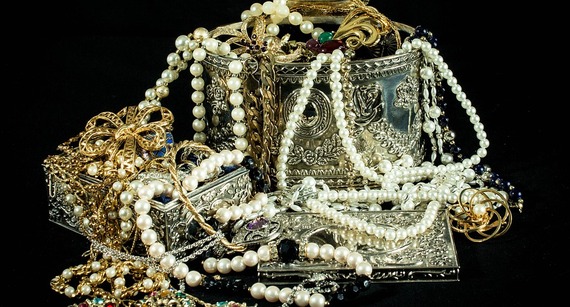
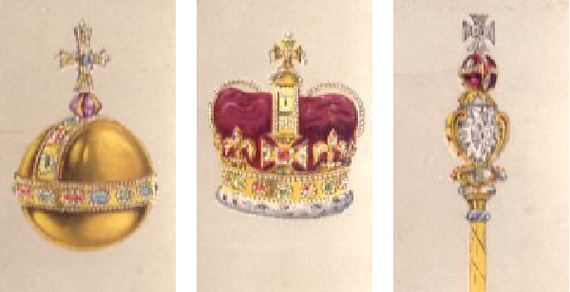 http://www.historic-uk.com/HistoryUK/HistoryofEngland/The-Theft-of-the-Crown-Jewels/
http://www.historic-uk.com/HistoryUK/HistoryofEngland/The-Theft-of-the-Crown-Jewels/
